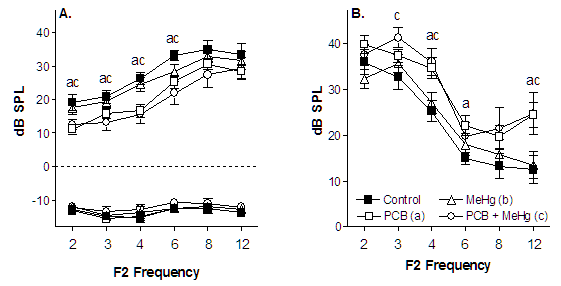2003 Progress Report: Neurobehavioral Effects of PCBs and Methylmercury in Rats
EPA Grant Number: R829390C001Subproject: this is subproject number 001 , established and managed by the Center Director under grant R829390
(EPA does not fund or establish subprojects; EPA awards and manages the overall grant for this center).
Center: CECEHDPR - University of Illinois FRIENDS Children’s Environmental Health Center
Center Director: Schantz, Susan L.
Title: Neurobehavioral Effects of PCBs and Methylmercury in Rats
Investigators: Schantz, Susan L.
Institution: University of Illinois at Urbana
EPA Project Officer: Saint, Chris
Project Period: October 17, 2001 through October 16, 2002
Project Period Covered by this Report: October 17, 2002 through October 16, 2003
RFA: Centers for Children's Environmental Health and Disease Prevention Research (2001)
Research Category: Children's Health , Health Effects
Description:
Objective:The objectives of this research project are to: (1) characterize the cognitive, motor, and sensory effects of perinatal exposure to polychlorinated biphenyls (PCBs) alone, methylmercury (MeHg) alone, or PCBs and MeHg in combination in the laboratory rat; (2) investigate the role of changes in specific neurotransmitter systems in mediating specific behavioral effects; (3) investigate the role of altered thyroid hormones in mediating specific behavioral effects; and (4) use the results from these animal experiments to guide the selection of behavioral tests for use in children exposed to PCBs and MeHg through maternal consumption of contaminated fish.
Progress Summary:Preliminary behavioral studies assessing the combined effects of PCBs (A1254) and MeHg on cognitive and motor function were completed during the past year. Both PCBs and MeHg produced deficits in spatial learning and memory, but combined exposure to the two chemicals did not exacerbate the deficit seen with either chemical alone. The pattern of the deficit suggested impaired attentional or associational processes rather than impaired memory function. We currently are developing an attentional task that will help us to define further the nature of this cognitive deficit. In contrast to the cognitive results, combined exposure to PCBs and MeHg did appear to have an additive effect on motor function. Neither chemical alone produced a significant deficit in motor function, but animals exposed to both PCBs and MeHg showed a clear deficit in balance and coordination as measured by their ability to cross a rotating rod. Manuscripts presenting the cognitive and motor results are in preparation.
Preliminary studies of auditory function still are underway. Measurements of distortion product otoacoustic emissions (DPOAEs), which provide a direct measure of cochlear function, suggest that PCB-related hearing deficits may be present across a broader range of frequencies than indicated by previous studies using less sensitive assessment techniques (Figure 1). MeHg does not appear to affect cochlear function. Statistical analysis of the DPOAE results revealed significant main effects of exposure for both DPOAE amplitude (expressed as signal-to-noise ratio; p = 0.01) and threshold (p = 0.002). Comparisons of the exposed groups to the control group indicated that exposure to PCBs alone or PCBs and MeHg reduced the signal-to-noise ratio across all frequencies tested, with significant reductions at 2, 3, 4, and 6 KHz. DPOAE thresholds were increased across all frequencies, with significant differences at 3, 4, 6, and 12 KHz. MeHg alone did not alter DPOAE amplitudes or thresholds, and exposure to MeHg did not exacerbate the effects of PCBs. These results confirm earlier reports of PCB-related hearing loss and implicate the cochlea as a primary site of damage.

Figure 1. DPOAE Signal-to-Noise Ratios (A) Were Reduced and Thresholds (B) Were Increased Across all Frequencies in the PCB and PCB + MeHg Groups (a and c indicate p < 0.05).
Studies of auditory brainstem-evoked responses and behavioral measurements of auditory thresholds still are underway. Initial studies using the newly formulated Fox River PCB mix began recently, and behavioral and sensory assessments of these animals will begin during the summer of 2003.
Future Activities:The investigators did not report any future activities.
Journal Articles on this Report: 1 Displayed | Download in RIS Format
| Other subproject views: | All 15 publications | 6 publications in selected types | All 6 journal articles |
| Other center views: | All 40 publications | 24 publications in selected types | All 23 journal articles |
| Type | Citation | ||
|---|---|---|---|
|
|
Roegge CS, Wang VC, Powers BE, Klintsova A, Villareal S, Greenough WT, Schantz SL. Motor functions in rats exposed to PCBs and methylmercury during early development. Neurotoxicology and Teratology 2002;24(3):424-425. |
R829390C001 (2002) R829390C001 (2003) |
not available |
children’s health, disease and cumulative effects, ecological risk assessment, susceptibility, sensitive population, toxicology, Fox River, PCBs, exposure assessment, heavy metals, methylmercury, pesticides, fish consumption,
,
ENVIRONMENTAL MANAGEMENT, Scientific Discipline, Health, RFA, PHYSICAL ASPECTS, Susceptibility/Sensitive Population/Genetic Susceptibility, Molecular Biology/Genetics, Risk Assessment, Risk Assessments, genetic susceptability, Health Risk Assessment, Physical Processes, Epidemiology, Children's Health, Environmental Chemistry, biomarkers, developmental neurotoxicology, environmental hazard exposures, neurodevelopmental toxicity, methylmercury, developmental effects, neurotransmitters, assessment of exposure, childhood cancer, PCBs, toxics, sensitive populations, neurotoxic, biological markers, children, residential populations, exposure, PCB, children's vulnerablity, neurobehavioral effects, human exposure, Human Health Risk Assessment
Relevant Websites:
http://www.cvm.uiuc.edu/vb/friends_center/ ![]()
Progress and Final Reports:
2002 Progress Report
Original Abstract
2004 Progress Report
2005 Progress Report
Main Center Abstract and Reports:
R829390 CECEHDPR - University of Illinois FRIENDS Children’s Environmental Health Center
Subprojects under this Center:
(EPA does not fund or establish subprojects; EPA awards and manages the overall grant for this center).
R829390C001 Neurobehavioral Effects of PCBs and Methylmercury in Rats
R829390C002 Perinatal PCB Exposure and Neuropsychological/Auditory Function
R829390C003 FRIENDS Analytical Toxicology Core Facility
R829390C004 Developmental Effects of PCBs and Methylmercury
![[logo] US EPA](https://webarchive.library.unt.edu/eot2008/20081105220811im_/http://www.epa.gov/epafiles/images/logo_epaseal.gif)